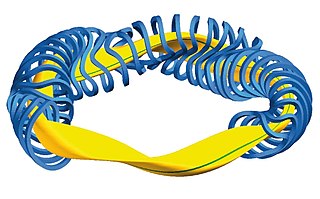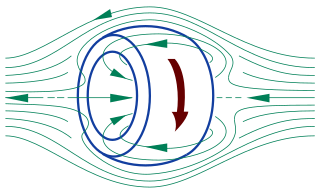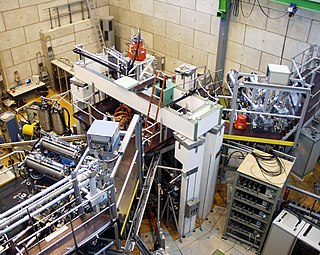Related Research Articles

A stellarator is a device that confines plasma using external magnets. Scientists aim to use stellarators to achieve controlled nuclear fusion. It is one of many types of magnetic confinement fusion devices, the most common being the tokamak. The name "stellarator" refers to stars as fusion also occurs in stars such as the Sun. It is one of the earliest fusion power devices, along with the z-pinch and magnetic mirror.

A tokamak is a device which uses a powerful magnetic field generated by external magnets to confine plasma in the shape of an axially-symmetrical torus. The tokamak is one of several types of magnetic confinement devices being developed to produce controlled thermonuclear fusion power. The tokamak concept is currently one of the leading candidates for a practical fusion reactor.

Princeton Plasma Physics Laboratory (PPPL) is a United States Department of Energy national laboratory for plasma physics and nuclear fusion science. Its primary mission is research into and development of fusion as an energy source. It is known for the development of the stellarator and tokamak designs, along with numerous fundamental advances in plasma physics and the exploration of many other plasma confinement concepts.

In plasma physics, plasma stability concerns the stability properties of a plasma in equilibrium and its behavior under small perturbations. The stability of the system determines if the perturbations will grow, oscillate, or be damped out. It is an important consideration in topics such as nuclear fusion and astrophysical plasma.

Fusion power is a proposed form of power generation that would generate electricity by using heat from nuclear fusion reactions. In a fusion process, two lighter atomic nuclei combine to form a heavier nucleus, while releasing energy. Devices designed to harness this energy are known as fusion reactors. Research into fusion reactors began in the 1940s, but as of 2024, no device has reached net power, although net positive reactions have been achieved.
This timeline of nuclear fusion is an incomplete chronological summary of significant events in the study and use of nuclear fusion.

The Tokamak Fusion Test Reactor (TFTR) was an experimental tokamak built at Princeton Plasma Physics Laboratory (PPPL) circa 1980 and entering service in 1982. TFTR was designed with the explicit goal of reaching scientific breakeven, the point where the heat being released from the fusion reactions in the plasma is equal or greater than the heating being supplied to the plasma by external devices to warm it up.

Magnetic confinement fusion (MCF) is an approach to generate thermonuclear fusion power that uses magnetic fields to confine fusion fuel in the form of a plasma. Magnetic confinement is one of two major branches of controlled fusion research, along with inertial confinement fusion.

A field-reversed configuration (FRC) is a type of plasma device studied as a means of producing nuclear fusion. It confines a plasma on closed magnetic field lines without a central penetration. In an FRC, the plasma has the form of a self-stable torus, similar to a smoke ring.

A spheromak is an arrangement of plasma formed into a toroidal shape similar to a smoke ring. The spheromak contains large internal electric currents and their associated magnetic fields arranged so the magnetohydrodynamic forces within the spheromak are nearly balanced, resulting in long-lived (microsecond) confinement times without external fields. Spheromaks belong to a type of plasma configuration referred to as the compact toroids. A spheromak can be made and sustained using magnetic flux injection, leading to a dynomak.
The Enormous Toroidal Plasma Device (ETPD) is an experimental physics device housed at the Basic Plasma Science Facility at University of California, Los Angeles (UCLA). It previously operated as the Electric Tokamak (ET) between 1999 and 2006 and was noted for being the world's largest tokamak before being decommissioned due to the lack of support and funding. The machine was renamed to ETPD in 2009. At present, the machine is undergoing upgrades to be re-purposed into a general laboratory for experimental plasma physics research.

The tokamak à configuration variable is an experimental tokamak located at the École Polytechnique Fédérale de Lausanne (EPFL) Swiss Plasma Center (SPC) in Lausanne, Switzerland. As the largest experimental facility of the Swiss Plasma Center, the TCV tokamak explores the physics of magnetic confinement fusion. It distinguishes itself from other tokamaks with its specialized plasma shaping capability, which can produce diverse plasma shapes without requiring hardware modifications.

The Tokamak de Fontenay-aux-Roses, TFR for short, was the first French tokamak, built in a research centre of the French Atomic Energy Commission (CEA) in Fontenay-aux-Roses, a commune in the southwestern suburbs of Paris. The project was spearheaded by Paul-Henri Rebut, and is sometimes jokingly referred to as the "Tokamak façon Rebut".

A spherical tokamak is a type of fusion power device based on the tokamak principle. It is notable for its very narrow profile, or aspect ratio. A traditional tokamak has a toroidal confinement area that gives it an overall shape similar to a donut, complete with a large hole in the middle. The spherical tokamak reduces the size of the hole as much as possible, resulting in a plasma shape that is almost spherical, often compared to a cored apple. The spherical tokamak is sometimes referred to as a spherical torus and often shortened to ST.

Dynomak is a spheromak fusion reactor concept developed by the University of Washington using U.S. Department of Energy funding.
In plasma physics and magnetic confinement fusion, the high-confinement mode (H-mode) is a phenomenon and operating regime of enhanced confinement in toroidal plasma such as tokamaks. When the applied heating power is raised above some threshold, a toroidal plasma transitions abruptly from the low-confinement mode (L-mode) to the H-mode where the energy confinement time approximately doubles in magnitude.

The Princeton Large Torus, was an early tokamak built at the Princeton Plasma Physics Laboratory (PPPL). It was one of the first large scale tokamak machines and among the most powerful in terms of current and magnetic fields. Originally built to demonstrate that larger devices would have better confinement times, it was later modified to perform heating of the plasma fuel, a requirement of any practical fusion power device.
The Model C stellarator was the first large-scale stellarator to be built, during the early stages of fusion power research. Planned since 1952, construction began in 1961 at what is today the Princeton Plasma Physics Laboratory (PPPL). The Model C followed the table-top sized Model A, and a series of Model B machines that refined the stellarator concept and provided the basis for the Model C, which intended to reach break-even conditions. Model C ultimately failed to reach this goal, producing electron temperatures of 400 eV when about 100,000 were needed. In 1969, after UK researchers confirmed that the USSR's T-3 tokamak was reaching 1000 eV, the Model C was converted to the Symmetrical Tokamak, and stellarator development at PPPL ended.
The Tokamak Physics Experiment (TPX) was a plasma physics experiment that was designed but not built. It was designed by an inter-organizational team in the USA led by Princeton Plasma Physics Laboratory. The experiment was designed to test theories about how Tokamaks would behave in a high-performance, steady-state regime.
References
- ↑ New York Times 1974.
- ↑ New York Times 1969.
- 1 2 3 4 5 Vocational Biographies.
- ↑ Goldston 1975.
- ↑ Goldston et al. 1987.
- ↑ Goldston & Towner 1981.
- ↑ Goldston, White & Boozer 1981.
- ↑ APS 2015.
- ↑ Goldston 1984.
- ↑ Economist 2004.
- ↑ Goldston & Rutherford 1995.
- ↑ Goldston 1996.
- ↑ "APS Fellow Archive". APS. Retrieved 25 September 2020.
- ↑ Mohan 2014.
- ↑ Foreign Policy 2014.